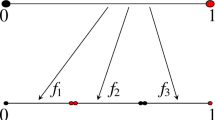Abstract
A minimal Cantor system is said to be self-induced whenever it is conjugate to one of its induced systems. Substitution subshifts and some odometers are classical examples, and we show that these are the only examples in the equicontinuous or expansive case. Nevertheless, we exhibit a zero entropy self-induced system that is neither equicontinuous nor expansive. We also provide non-uniquely ergodic self-induced systems with infinite entropy. Moreover, we give a characterization of self-induced minimal Cantor systems in terms of substitutions on finite or infinite alphabets.
Similar content being viewed by others
References
P. Arnoux, Un exemple de semi-conjugaison entre un échange d’intervalles et une translation sur le tore, Bull. Soc. Math. France 116 (1988), 489–500.
P. Arnoux and S. Ito, Pisot substitutions and Rauzy fractals Bull, Belg. Math. Soc. 8 (2001), 181–207.
P. Arnoux and G. Rauzy, Représentation géométrique de suites de complexité 2n + 1, Bull. Soc. Math. France 119 (1991), 199–215.
M. Boshernitzan and C. R. Carroll, An extension of Lagrange’s theorem to interval exchange transformations over quadratic fields, J. Anal. Math. 72 (1997), 21–44.
X. Bressaud and Y. Jullian, Interval exchange transformation extension of a substitution dynamical system, Confluentes Math. 4, (2012), no. 4, 1250005.
E. Coven, A. Dykstra, M. Keane, and M. LeMasurier, Topological conjugacy to given constant length substitution minimal systems, Indag. Math. (N.S.) 25 (2014), 646–651.
H. Dahl and M. Molberg, Induced subsystems associated to a Cantor minimal system, Colloq. Math. 117 (2009), 207–221.
P. Dartnell, F. Durand, and A. Maass, Orbit equivalence and Kakutani equivalence with Sturmian subshifts, Studia Math. 142 (2000), 25–45.
A. del Junco, D. J. Rudolph, and B. Weiss, Measured topological orbit and Kakutani equivalence, Discrete Contin. Dyn Syst. Ser. S, 2 (2009), 221–238.
T. Downarowicz, Survey of odometers and Toeplitz flows,in Algebraic and Topological Dynamics, Amer. Math. Soc., Providence RI, 2005, pp. 7–37.
T. Downarowicz and A. Maass, Finite-rank Bratteli-Vershik diagrams are expansive, Ergodic Theory Dynam. Systems 28 (2008), 739–747.
F. Durand. Contributions à l’étude des suites et systèmes dynamiques substitutifs, Ph.D. thesis, Université de la Méditerranée (Aix-Marseille II), 1996.
F. Durand, A characterization of substitutive sequences using return words, Discrete Math. 179 (1998), 89–101.
F. Durand, Combinatorics on Bratteli diagrams and dynamical systems, in Combinatorics, Automata and Number Theory, Cambridge Univ. Press, Cambridge, 2010, pp. 324–372.
F. Durand, Decidability of uniform recurrence of morphic sequences, Internat. J. Found. Comput. Sci. 24 (2013), 123–146.
F. Durand, B. Host, and C. Skau, Substitutive dynamical systems, Bratteli diagrams and dimension groups, Ergodic Theory Dynam. Systems 19 (1999), 953–993.
A. Dykstra and D. J. Rudolph, Any two irrational rotations are nearly continuously Kakutani equivalent, J. Anal. Math. 110 (2010), 339–384.
S. Ferenczi, Systems of finite rank, Colloq. Math. 73 (1997), 35–65.
S. Ferenczi, Substitution dynamical systems on infinite alphabets, Ann. Inst. Fourier (Grenoble) 56 (2006), 2315–2343.
S. Ferenczi, C. Holton, and L. Q. Zamboni, Structure of three-interval exchange transformations. II. A combinatorial description of the trajectories, J. Anal. Math. 89 (2003), 239–276.
S. Ferenczi, C. Mauduit, and A. Nogueira, Substitution dynamical systems: algebraic characterization of eigenvalues, Ann. Sci. Ecole Norm. Sup. 29 (1996), 519–533.
N. P. Fogg, Substitutions in Dynamics, Arithmetics and Combinatorics, Springer-Verlag, Berlin, 2002.
T. Giordano, I. Putnam, and C. Skau, Topological orbit equivalence and C* crossed products, J. Reine Angew. Math. 469 (1995), 51–111.
R. Gjerde and O. Johansen, Bratteli-Vershik models for cantor minimal systems: applications to Toeplitz flows, Ergodic Theory Dynam. Systems 20 (2000), 1687–1710.
R. Gjerde and O. Johansen, Bratteli-Vershik models for Cantor minimal systems associated to interval exchange transformations, Math. Scand. 90 (2002), 87–100.
R. H. Herman, I. Putnam, and C. F. Skau, Ordered Bratteli diagrams, dimension groups and topological dynamics, Internat. J. Math. 3 (1992), 827–864.
Y. Jullian, An algorithm to identify automorphisms which arise from self-induced interval exchange transformations, Math. Z. 274 (2013), 33–55.
W. Kosek, N. Ormes, and D. J. Rudolph, Flow-orbit equivalence for minimal Cantor systems, Ergodic Theory Dynam. Systems, 28 (2008), 481–500.
P. Kurka, Topological and Symbolic Dynamics, Société Mathématique de France, Paris, 2003.
D. Lind and B. Marcus, An Introduction to Symbolic Dynamics and Coding, Cambridge Univ. Press, Cambridge, 1995.
X. Méla and K. Petersen, Dynamical properties of the Pascal adic transformation, Ergodic Theory Dynam. Systems 25 (2005), 227–256.
B. Mossé, Puissances de mots et reconnaissabilité des points fixes d’une substitution, Theoret. Comput. Sci. 99 (1992), 327–334.
B. Mossé, Reconnaissabilité des substitutions et complexité des suites automatiques, Bull. Soc. Math. France 124 (1996), 329–346.
A. Nogueira, Nonorientable recurrence of flows and interval exchange transformations, J. Differential Equations 70 (1987), 53–166.
D. S. Ornstein, D. J. Rudolph, and B. Weiss, Equivalence of measure preserving transformations, Mem. Amer. Math. Society, Providence RI, 1982.
K. Petersen, Ergodic Theory, Cambridge Univ. Press, Cambridge, 1983.
M. Queffélec, Substitution Dynamical Systems–Spectral Analysis, Springer-Verlag, Berlin, 1987.
G. Rauzy, Échanges d’intervalles et transformations induites, Acta Arith. 34 (1979), 315–328.
G. Rauzy, Nombres algébriques et substitutions, Bull. Soc. Math. France 110 (1982), 147–178.
M. R. Roychowdhury and D. J. Rudolph, Nearly continuous Kakutani equivalence of adding machines, J. Mod. Dyn. 3 (2009), 103–119.
W. Veech, Interval exchange transformations, J. Anal. Math. 33 (1978), 222–272.
S. Williams Toeplitz minimal flows which are not uniquely ergodic, Z. Wahrsch. Verw. Gebiete 67 (1984), 95–107.
Author information
Authors and Affiliations
Corresponding author
Rights and permissions
About this article
Cite this article
Durand, F., Ormes, N. & Petite, S. Self-induced systems. JAMA 135, 725–756 (2018). https://doi.org/10.1007/s11854-018-0051-x
Received:
Revised:
Published:
Issue Date:
DOI: https://doi.org/10.1007/s11854-018-0051-x




